|
Electricity (Late Payment Surcharge and Related Matters) Rules, 2022 gives relief to the DISCOMs, electricity consumers and Generating companies which will help the whole power sector to become financially viable. Total over dues amounting to ₹ 26,546 crores have been settled between 05.08.2022 and 21.09.2022 Green Open Access Rules reduces the Open Access limit from 1 MW to 100 kW, which pave the way for small consumers also to purchase RE and there is no limit for Captive Consumers. Ministry of Power promulgated the Electricity (Right of Consumers) Rules 2020 with the conviction that the power systems exist to serve the consumers and the consumers have rights to get the reliable services and quality electricity. As per BESS bidding Guidelines, a pilot project on 1000MWh Battery Energy Storage System (BESS) has been awarded based on transparent bidding. So far under RDSS, 17,34,39,869 prepaid Smart meters, 49,02,755 numbers of DT meters and 1,68,085 numbers of Feeder meter have been sanctioned across 23 States/40 Discoms with a total sanctioned cost of INR 1,15,493.79 Cr. A total of around 83,887 Metric tonnes of Biomass has been utilized (till 31st October) as green fuel for co-firing in Power Plants so far. Till 30.10.2022, 39 TPPs across the country has started to utilize biomass in the co-firing with coal. Under OSOWOG, an Indian technical team has visited Maldives shortly for studying the technical specifications of interconnection between India and Maldives through Lakshadweep. Ministry of Power constituted a high-level committee which prepared a detailed Plan titled “Transmission System for Integration of over 500 GW RE Capacity by 2030″ in consultation with States and other stakeholders. The planned transmission system projected will provide a visibility to the Renewable Energy Developers about the potential generation sites and scale of investment opportunity. Further, it will also provide the Transmission Service Providers the vision of growth opportunity available in the transmission sector along with investment opportunity of about 2.44 lakh crore.
All the 04 units of Kameng Hydro Power Project (600 MW) constructed by NEEPCO in Arunachal Pradesh have been fully commissioned and have commenced their operation from 12.02.2021.
Till date, over 36.86 crore LED bulbs, 72.18 lakh LED Tube lights and 23.59 lakh Energy efficient fans (including over 55,000 BLDC fans) have been distributed by EESL across India. This has resulted in estimated energy savings of 48.39 billion kWh per year with avoided peak demand of 9,788 MW, GHG emission reduction of 39.30 million t CO2 per year and estimated annual monetary savings of INR 19,332 crore in consumer electricity bills. EESL has installed over 1.26 crore LED Street Lights in ULBs and Gram Panchayats across India till date. |
MAJOR ACHIEVEMENTS & SCHEMES OF MINISTRY OF POWER
Statutory Mechanism for timely payment of Generating Companies
- Electricity (Late Payment Surcharge and Related Matters) Rules, 2022 give relief to the DISCOMs, as well as electricity consumers and at the same time Generating companies also getting the benefit from assured monthly payments, which will help the whole power sector to become financially viable. It will create a win-win situation to both Discoms and Gencos.
- Provision has been made for one-time scheme for liquidation of arrears, enabling DISCOMs to pay total outstanding dues including LPS as on the date of notification, in upto 48 number of monthly installments. No LPS on past outstanding dues will be applicable in case of timely payment of these installments. It will bring discipline in timely payment of dues.
- All current dues are being paid since August 2022 within a timeframe of 75 days maximum.
- Total overdues amounting to ₹ 26,546 crores have been settled between 05.08.2022 and 21.09.2022 and 13 States/ UTs (total outstanding of Rs. 1,38,073 Cr.) have chosen for EMI option and paid installment of Rs 9528 Cr. (1st and 2nd EMI). 9 out of these 13 states opted for loans from PFC/ REC ( total loan sanctioned of Rs 92,214 Cr). Further, 20 States/ UTs reported to have no outstanding dues as on 03.06.2022.
- It will also benefit DISCOMs in form of no liability towards LPS, which will ultimately benefit the electricity consumers. DISCOMs will also be benefitted by way of reduction of LPS from 18% to a rate linked to Bank lending rate. If bank rate reduces, the LPS will also reduce, resulting in lower tariff for the consumers. Regulation of power supply is mandated in case of non- maintenance of PSM or continuation of default in payment of outstanding dues. Provision for regulation of short-term, medium–term and long-term access may be in a gradual manner in case of non- payment of dues even after 2.5 months from bill presentation has been made to ensure timely payment of dues.
- Through special provisions for ensuring supply obligation of the Generating Company to maintain sanctity of PPAs, DISCOMs’ interests are protected to avoid supplying the power in Power Market during high market price period instead of to DISCOMs as per PPA. At the same time, it ensures the Generators’ viability by allowing them to sell in power market in the event of non- maintenance of PSM and continuous payment default of DISCOMs.
- Ministry of Power has circulated the broad framework for implementation of the Rules vide letter dated 11.08.2022 and PFC has been designated as the Nodal Agency for implementation of Rules. Operationalization of rules is being done through an automated process using existing PRAAPTI Portal and POSOCO Portal by on boarding DISCOMs on the Portal.
- Further in order to streamline the process of monitoring of payments of regular bills of suppliers by the DISCOMS and identifying defaults by the DISCOMs in payment of dues in payment of dues and consequent regulation of access to power as per Rules, Ministry of Power issued Standard Operating Procedure(SOP) vide letter dt 26.08.2022.

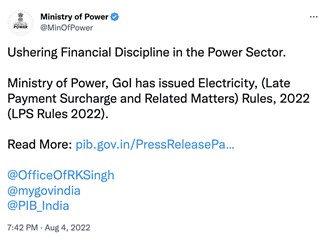
Electricity (Promoting Renewable Energy through Green Energy open Access) Rules, 2022
- For unshackling the RE Sector, i.e. to remove barriers in availability and utilisation of RE and to address the issues that have hindered the growth of open access for a long time, Green Open Access Rules, 2022 have been issued. The Rules reduces the Open Access limit from 1 MW to 100 kW, which pave the way for small consumers also to purchase RE and there is no limit for Captive Consumers.
- Any consumer can demand supply of Green power from DISCOMs. It will allow Commercial and Industrial Consumers to purchase RE on voluntarily basis. The Rules will streamline the Open Access approval process including timely approval, transparency, simplification. Approval of open access to be granted in 15 days or else it will be deemed to have been approved. The special provisions for cross-subsidy surcharge, additional surcharge, standby charge as well as for banking, will incentivise the consumers to get Green Power at reasonable rates. As per these Rules, the tariff for the green power will be determined by the Appropriate Commission, separately. For promoting Green Hydrogen/Green Ammonia and Waste to Energy Plants, Special concessions are given in the rules. POSOCO has been notified as Central Nodal Agency to set up and operate a single window green energy open access system for renewable energy.
- As mandated under these Rules to operationalise green open access, a web portal has been designed and developed by POSOCO the Central Nodal Agency, and launched on 11.11.2022. This portal will facilitate as a single platform for submitting and approval of applications for open access. This will ensure faster and easier open access for utilising green energy by all stakeholders. Further, as mandated under these Rules Forum of Regulators has formulated a model regulations on methodology for calculation of open access charges, as well as banking charges.

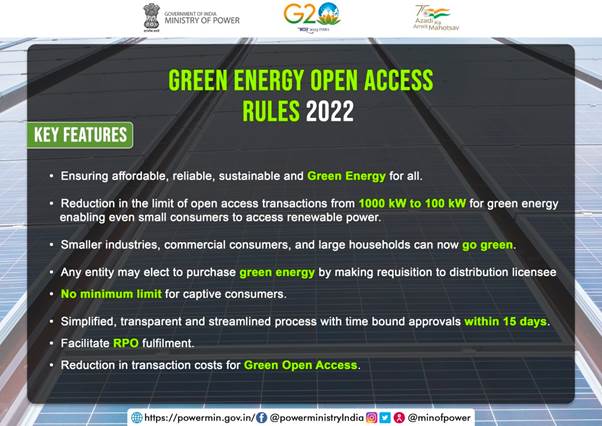
Amendment in Electricity Rights of Consumers Rules 2020
- With the objective of beginning an era of empowering Power Consumers, laying down rights of the consumers and a system of enforcement of these rights, while facilitating ease of doing business in power sector, the Ministry of Power promulgated the Electricity (Right of Consumers) Rules 2020 with the conviction that the power systems exist to serve the consumers and the consumers have rights to get the reliable services and quality electricity.
- These Rules lay down the time limits and standards for the various services to be provided by the Distribution Companies across the country, which are monopolies, to provide services in accordance with standards or pay compensation to their consumers. These Rules specify the obligations of the licensee and sets the practices that must be adopted by the licensee to provide efficient, cost-effective, reliable and consumer friendly services to the consumers. These rules are one of the evolving steps to enable the transformation of a DISCOM from a mere power supplying agency to a holistic consumer focused service provider.
- First amendment regarding net metering provisions under Consumer Rules 2020 was notified on 29th June, 2021.
- Another amendment to these Rules was notified 21st April, 2022, to specify the following parameters to maintain the reliability of supply by the distribution licensee namely System average interruption duration index (SAIDI) and System average interruption frequency index (SAIFI), customer average interruption duration index (CAIDI), customer average interruption frequency index (CAIFI) and momentary average interruption frequency index (MAIFI).
- Further the consumers, who are using the diesel generator sets as essential back up power, shall endeavor to shift to cleaner technology such as renewable energy with battery storage and the like in five years from the date of commencement of these rules or as per the timelines given by the State Commission for such replacement based on the reliability of supply in that city covered under area of supply of the distribution licensee.
Developing Energy Storage for RE Expansion-Notification of BESS Guidelines-
- Keeping in the view the need of large scale RE integration with the grid and achieving a smoother energy transition, Ministry of Power has notified Bidding Guidelines for Procurement and Utilization of Battery Energy Storage Systems on March 11, 2022. Based on the above BESS bidding Guidelines, a pilot project on 1000MWh Battery Energy Storage System (BESS) has been awarded based on transparent bidding.
Other Reforms:
- Scheme for Flexibility in Generation and scheduling in Thermal/hydro plant: Revised scheme for flexibility in generation and scheduling of Thermal/Hydro power station through bundling with Renewable Energy and storage power was issued on 15.11.2021. Revised scheme issued on 12.04.2022. Trajectory for replacement of Thermal Energy with about 58,000 MU (30,000 MW) of Renewable Energy by 2025-26 has been issued vide letter dated 26.05.2022.
- Renewable Purchase Obligation (RPO) and Energy Storage Obligation Trajectory till 2029-30 has been issued on 22.07.2022.
- Reducing Compliance Burden for Ease of Doing Business – Regulatory Compliance Portal of DPIIT: A total of 61 nos. of burdensome compliances have been reduced during the year 2022 and data updated on the portal.
- National Single Window System (NSWS): 20 applications (CEA, CTU, POSOCO) have been integrated with National Single Window System (NSWS).

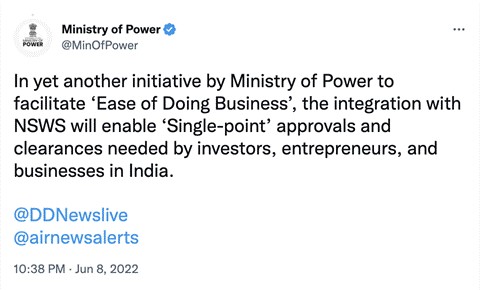
Revamped Distribution Sector Scheme (RDSS)
- The Government of India launched the Revamped Distribution Sector Scheme (RDSS) to help DISCOMs improve their operational efficiencies and financial sustainability by providing result-linked financial assistance to DISCOMs to strengthen supply infrastructure based on meeting pre-qualifying criteria and achieving basic minimum benchmarks. RDSS has an outlay of ~INR 3.04 lakh Cr. over 5 years i.e., FY 2021-22 to FY 2025-26. The outlay includes an estimated Government Budgetary Support (GBS) of ~INR 0.98 lakh Cr. The main objectives of RDSS are:
- Reduction of AT&C losses to pan-India levels of 12-15% by FY 2024-25.
- Reduction of ACS-ARR gap to zero by FY 2024-25.
- Improvement in the quality, reliability, and affordability of power supply to consumers through a financially sustainable and operationally efficient distribution sector.
- Prepaid Smart metering is the critical intervention envisaged under RDSS with an estimated outlay of ~Rs 1,50,000 Cr with ~GBS of 23,000 Cr and 250 Million prepaid smart meters are targeted to be installed during the Scheme period. Along with the prepaid Smart metering for consumers, system metering at feeder and DT level with communicating feature along with associated Advanced Metering Infrastructure (AMI) would be implemented under TOTEX mode (Total expenditure includes both capital and operational expenditure) thereby allowing the Discoms for measurement of energy flows at all level as well as energy accounting without any human interference. Proper and accurate energy accounting is the key for identification of high loss areas and theft prone areas, whereby, utilities billing and collection efficiencies will improve significantly, thereby reduces the AT&C losses of Discoms to the larger extent. Accordingly, with the installation of smart meters, utilities will be able to better manage their cash flows efficiently thereby facilitates reduction and AT&C loss of Utilities. Data gathered as part of the two-way communication in a smart metering solution will help utilities to improving their load forecasting, which will help them in optimizing their power procurement thereby reducing the cost of power supply.
- So far under RDSS, 17,34,39,869 prepaid Smart meters, 49,02,755 numbers of DT meters and 1,68,085 numbers of Feeder meter have been sanctioned across 23 States/40 Discoms with a total sanctioned cost of INR 1,15,493.79 Cr.
- Capital investment is also budgeted for loss reduction works, system strengthening to cater load growth and modernization to make smart distribution system under RDSS. Loss Reduction works majorly includes replacement of bare conductor with AB cable, HVDS systems, feeder bifurcation etc. Similarly, system strengthening includes creation of new substations, feeders, upgradation of transformation capacity, cables etc. Modernization includes SCADA, DMS, IT/OT, ERP, GIS enabled applications, ADMS etc. to make to make distributions systems smarter. So far, Loss Reduction works of ~INR 1.05 lakh Cr. (including PMA works) have been sanctioned for total 23 States/UTs and also Rs 2,663.97 Cr has been released as GBS towards loss reduction works under RDSSS as per scheme guidelines.

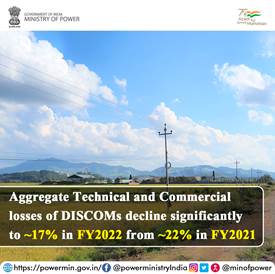

SAMARTH Mission
- To address the urgent issue of air pollution due to farm stubble burning and to reduce carbon footprints of thermal power generation, the Ministry of Power has decided to revise its “Policy for Biomass utilization for power generation through co-firing in coal based power plants ” through its order dated 08.10.2021. It has been mandated that all thermal power plants to use 5% blend of biomass pellets in the co-firing with coal.
- In order to support the energy transition in the country and to achieve the target of cleaner energy sources , Ministry of Power has constituted a National Mission on use of Biomass in coal based thermal power plants known as SAMARTH (Sustainable Agrarian Mission on use of Agri Residue in Thermal Power Plant) Mission. Under this National Mission, a full time body namely Mission Directorate has been constituted which is coordinating and monitoring the overall policy implementation and the targets of the National Mission.
- MoP issued Model Long term Contract for Biomass supply. The Minimum tenure of Model contract shall be Seven years. This will help in developing Biomass supply chain infrastructure.
- In order to encourage and send a message to the farmers to store paddy residue instead of burning it, a provision is included in Long term Model contract, which ensures Minimum 50% paddy straw in the composition of biomass pellets in the tenders for NCR plants. This condition in the Model contract will encourage the farmers for assured business and extra income.
- As a result of these efforts, a total of around 83,887 Metric tonnes of Biomass has been utilized (till 31st October) as Green fuel for co-firing in Power Plants so far. Till 30.10.2022, 39 TPPs across the country has started to utilize biomass in the co-firing with coal. It is expected that the efforts of MOP through the newly formed National Mission will be able to curtail air pollution in North West India as well as prevent loss of fertility of agriculture land and provide a sustainable income source for farmers, suppliers and Biomass fuel manufacturers resulting into overall development. It is expected that by active participation for implementation of the MoP policy on Biomass usage in true spirit by all stakeholders, targeted positive impact on the environment will lead a greener India in near future.
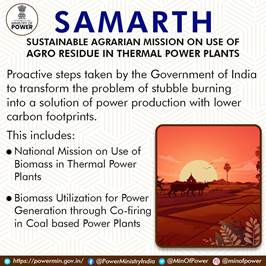

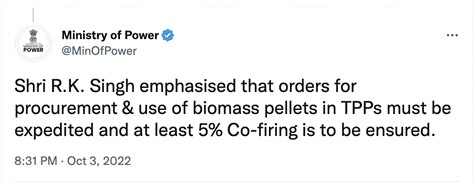
One Sun, One World, One Grid (OSOWOG)
- Ministry of Power constituted Task Force on OSOWOG for steering the agenda for OSOWOG. The Task Force studied techno-economic feasibility of interconnection of regional grids viz. South East Asia, South Asia, Middle East (Gulf Cooperation Council), Africa & Europe for exchange of renewable power and after discussion, it was agreed that initially interconnection with Sri Lanka, Myanmar and Maldives would be explored to further the objective of OSOWOG.
- An Indian technical team has visited Maldives shortly for studying the technical specifications of interconnection between India and Maldives through Lakshadweep.
- Charter for OSOWOG has been finalized, and a Steering Committee for OSOWOG is being set up.
Transmission Plan for integration of over 500 GW of non-fossil fuel capacity by 2030
- India has huge ambitions in energy transition and plans to have 500 GW of non-fossil based electricity installed capacity by 2030, so that non-fossil cleaner fuel comprises of 50% of the installed capacity mix by 2030. Ministry of Power had constituted a high level committee under Chairperson, Central Electricity Authority with representatives from Solar Energy Corporation of India, Central Transmission Utility of India Ltd, Power Grid Corporation of India Ltd, National Institute of Solar Energy, and National Institute of Wind Energy for planning the transmission system required for having 500 GW of non-fossil fuel based installed capacity by 2030. The Committee prepared a detailed Plan titled “Transmission System for Integration of over 500 GW RE Capacity by 2030” in consultation with States and other stakeholders.
- The Plan has identified major upcoming non-fossil based generation centres in the country, which include Fatehgarh, Bhadla, Bikaner in Rajasthan, Khavda in Gujarat, Anantapur, Kurnool RE Zones in Andhra Pradesh, offshore wind potentials in Tamil Nadu and Gujarat, RE park in Ladakh etc. and based on these potential generation centres, transmission systems have been planned. The Plan is a major step towards achievement of the goal of integrating 500 GW of non-fossil fuel based capacity by 2030 by providing broad plan of required transmission system for having 537 GW of Renewable Energy capacity by the year 2030. The transmission plan projected addition of 8120ckm of High Voltage Direct Current Transmission corridors (+800 kV and +350 kV), 25,960 ckm of 765 kV ac lines, 15,758 ckm of 400 kV lines and 1052 ckm of 220 kV cable at an estimated cost of 2.44 lakh crore. The transmission plan also includes transmission system required for evacuation of 10 GW off-shore wind located in Gujarat and Tamilnadu at an estimated cost of Rs. 0.28 lakh crore. With the planned transmission system, the inter-regional capacity will increase to about 1.50 lakh MW by 2030 from 1.12 lakh MW at present. Considering the availability of Renewable Energy based generation for a limited period during day, the Plan also envisages installation of Battery Energy Storage Capacity of the order of 51.5 GW by 2030 to provide Round the Clock power to end-consumers.
- The planned transmission system projected will provide a visibility to the Renewable Energy Developers about the potential generation sites and scale of investment opportunity. Further, it will also provide the Transmission Service Providers the vision of growth opportunity available in the transmission sector along with investment opportunity of about 2.44 lakh crore.

Addition in Transmission Capacity
- During 2022 (upto November 2022), 11,846 ckm of transmission lines and 68,401 MVA of transformation capacity has been added. Details are given below:
| SL no. | Data Set | Value as on 30.11.2022 | Value as on 31.12.2021 | Addition in 2022 (till 30.11.2022) |
| (i) | Transmission line capacity (ckm) | 4,64,286 | 4,52,440 | 11846 |
| (ii) | Transformation Capacity (MVA) | 11,48,167 | 10,79,766 | 68401 |
| (iii) | Inter-regional Transfer capacity (MW) | 1,12,250 | 1,12,250 | 0 |
Hydro Power Development:
- Guidelines for providing Budgetary support for Flood Moderation / Storage Hydro Electric Power projects and Cost of Enabling Infrastructure i.e. roads and bridges were issued by the Ministry on 28.09.2021 to promote the Hydro Sector.
- Dispute Avoidance Mechanism for avoidance/ resolution of contractual disputes at initial stage by engagement of an Independent Engineer and Dispute Resolution Mechanism for resolution of disputes through Conciliation Committees have been devised by MoP. During the year 2022-23, till date, 4 no. cases of disputes have been allotted/ under allocation to the Conciliation Committees of Independent Experts (CCIE) and 7 no. of Independent Engineers have been appointed in the various contracts of Hydro CPSUs for resolution/ avoidance of disputes.
- IT based monitoring system is being introduced for close monitoring of the hydro projects. The IT portal in this regard has been prepared and presently training to developers and filling of data is in progress. The Portal is scheduled to be fully functional with relevant data by Dec’22.
- In the context of energy transition goals set for the country, Ministry of Power vide its communication dated 22.12.2021 conveyed the Basin-wise indication of projects in NER to the Hydro CPSUs.
- All the 04 units of Kameng Hydro Power Project (600 MW) constructed by NEEPCO in Arunachal Pradesh have been fully commissioned and have commenced their operation from 12.02.2021.The project was dedicated to the Nation by Hon’ble Prime Minister on 19.11.2022, virtually.
- Vyasi Hydro Electric Project (120 MW) in Uttarakhand (Executing Agency: UJVNL) was commissioned during May 2022.
- Investment approval for 850 MW Ratle Hydro Electric Project has been accorded on 11.02.2021 with an estimated project cost of Rs. 5281.94 crore (November 2018 PL). The project is scheduled to be completed within 60 months from the date of investment approval.
- Investment approval for 120 MW Rangit-IV Hydroelectric Project has been accorded on 30.03.2021 with an estimated project cost of Rs.938.29 crore (October 2019 PL). The project is scheduled to be completed within 60 months from the date of investment approval.
- Lower Arun Hydro Electric Project (600 MW) in Nepal: Lower Arun project was allotted to SJVN Ltd by Government of Nepal (GoN) on Build Own Operate and Transfer (BOOT) basis through international competitive bidding on 04.02.2021.
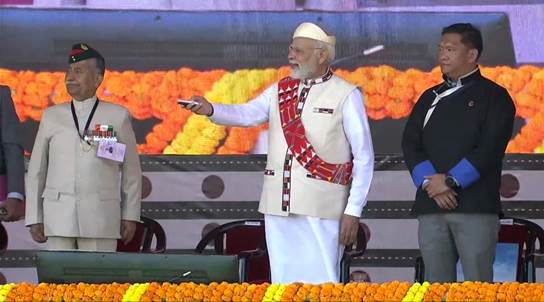

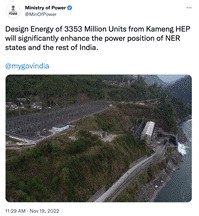
Unnat Jyoti by Affordable LEDs for ALL (UJALA)
- Hon’ble Prime Minister, on 5th January 2015 launched Unnat Jyoti by Affordable LED for All (UJALA) programme. Under UJALA scheme, LED bulbs, LED Tube lights and Energy efficient fans are being sold to the domestic consumers for replacement of conventional and inefficient variants.
- Till date, over 36.86 crore LED bulbs, 72.18 lakh LED Tube lights and 23.59 lakh Energy efficient fans (including over 55,000 BLDC fans)have been distributed by EESL across India. This has resulted in estimated energy savings of 48.39 billion kWh per year with avoided peak demand of 9,788 MW, GHG emission reduction of 39.30 million t CO2 per year and estimated annual monetary savings of INR 19,332 crore in consumer electricity bills. The above programme has been successful in creating the market for above appliances by bring down their price significantly and making them affordable for consumers.

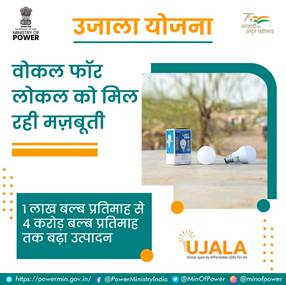
Street Lighting National Programme (SLNP)
- Hon’ble Prime Minister, on 5th January, 2015 launched Street Lighting National Programme (SLNP) to replace conventional street lights with smart and energy efficient LED street lights across India.
- Till date, EESL has installed over 1.26 crore LED Street Lights in ULBs and Gram Panchayats across India. This has resulted in estimated energy savings of 8.50 billion kWh per year with avoided peak demand of 1,416 MW, GHG emission reduction of 5.85 million t CO2 per year and estimated annual monetary savings of INR 5,947 crore in electricity bills of municipalities.

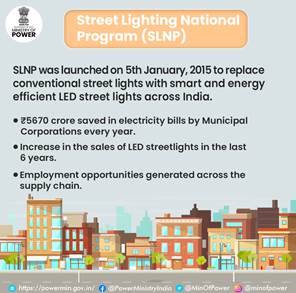

Comments are closed.